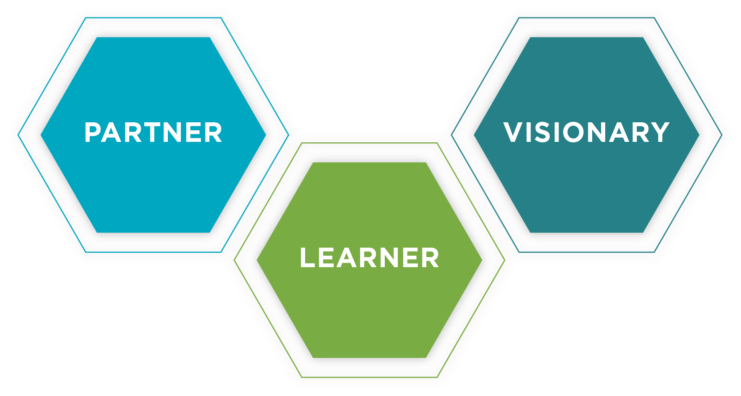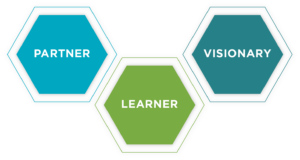
Principal effectiveness: What really matters
In February the Wallace Foundation published a report that synthesizes over 20 years of research about effective leaders. But, What does it mean to be an effective leader? How do effective leaders support equitable outcomes for students?
Through years of working with principals and school sites, what has become clear is that a “leader” is not one dimensional but holds the mindsets of a learner, partner, and visionary simultaneously to orient towards educational equity. Our Leader Profile Framework, of a learner, partner, and visionary, demystifies the “conditions for adult learning” that are so central to effective principal leadership and to creating cultures equity.
This profile serves as a self assessment, a coaching tool, as well as a visioning tool to help learning organizations both support and build self awareness around effective leaders.

Partner
Partnership is key to effective leadership. The Wallace Foundation in their report “How Principals Affect Student Outcomes” refers to this as the primary skill area of “People.” To us, people-centered partnership means to be in conversation and to deeply listen with empathy and care to your colleagues, teachers, and students. This equity approach of deeply listening not only builds relationships and trust, but allows for distributed leadership and agency throughout the school community.
A leader who is a Partner:
- Values multiple perspectives and seeks thought partnerships
- Deeply listens with empathy and care, looking first for assets/connections
- Builds relationships that cultivate a culture of professional respect, trust, agency, and distributed leadership
- Supports rigorous learning steeped in SEL
One of our principal partners exemplifies what it means to be a partner. He found himself uncertain about data he was receiving about his marginalized students. A large number of them were both not attending classes and not passing classes. Instead of grappling and creating a plan alone, he took a partnership approach. He vulnerably shared this data and his wonderings with his principal colleagues. By inviting multiple perspectives into his thinking and uncertainties, he was able to better understand his dilemma and how he might move forward. Next, he met with his Instructional Leadership Team (ILT) and invited them to grapple with him about the data he was unsure about. Together they noticed inequitable patterns in student achievement and mapped out how they would share the data with their departments in order to deepen collective awareness and identify shared action. What started as a leader’s question became a powerful collaborative process that leveraged the expertise of others, built professional trust, and empowered agency to be felt across the system.
Learner
Leaders who are learners operate from a place of curiosity and encourage their teachers to be curious too. They don’t assume that they have all the answers; rather, they model the learning stance they want their teachers to hold in order to uncover the learners’ experience, openly talk about what they don’t know, and adapt their practice to meet the needs of their learners. Effective leaders who are learners understand that the status quo has not been working for all students and that in order to reach equitable outcomes, schools must constantly ask themselves courageous questions and adjust in culturally responsive ways.
A Leader who is a Learner:
- Publicly models a learning stance (curiosity, vulnerability, trust, flexibility, adaptability)
- Uses data to uncover the learner’s experience
- Adapts and improves by deepening self-awareness
- Leads collaborative learning by experiencing and reflecting on conditions that supported their own learning (SEL, Quality of Interaction)
One of our partner principals wanted to help her teachers increase the rigor in their instruction to improve student learning. Though her graduation data was high, there were still large achievement gaps in both literacy and math, especially for her African American male students and English learners. Instead of “PD’ing” her staff, she took a learner’s stance by deepening her understanding of what they knew and what they needed to know through collecting data on her teacher’s understanding through classroom observations. By grounding in the data she collected through classroom visits, her next steps were data driven. Additionally, she vulnerably became a Public Learner with both her principal partners and with her Instructional Leadership Team by sharing this data and inviting them to shine a light on possible blind spots and assumptions that may have held her thinking back.
Visionary
The third capacity of an effective leader is that of a visionary. For an effective leader, their vision connects back to their internal moral compass, their “why”. When an effective leader is guided by a strong moral imperative, their learning, their decision-making, and their actions are tied to what they want for their whole school, with a focus on the most marginalized students and families. By getting clear and naming their vision, a visionary leader is able to create a space driven not by compliance, but by curiosity, care, personal responsibility, and collective efficacy.
A leader who is a visionary:
- Puts students at the center of learning by identifying and returning to high leverage goals that target students’ needs
- Communicates purpose and progress in humanizing, authentic ways to build awareness and support continuous improvement
- Creates space to move beyond transactional compliance to curiosity and collective efficacy
- Is driven by a moral imperative
One of the effective leaders we work with has a clear “why” for his work. He knows what students he wants to focus on and why this focus matters. These students are not numbers or percentages to him but names, families, and people. Because of this, his messaging for his teachers and staff is also clear and rooted in equity. He is able to communicate this purpose and galvanize his community around this purpose as well. When he looks at learning data he sees what his students can do and will do as his team moves forward together.
